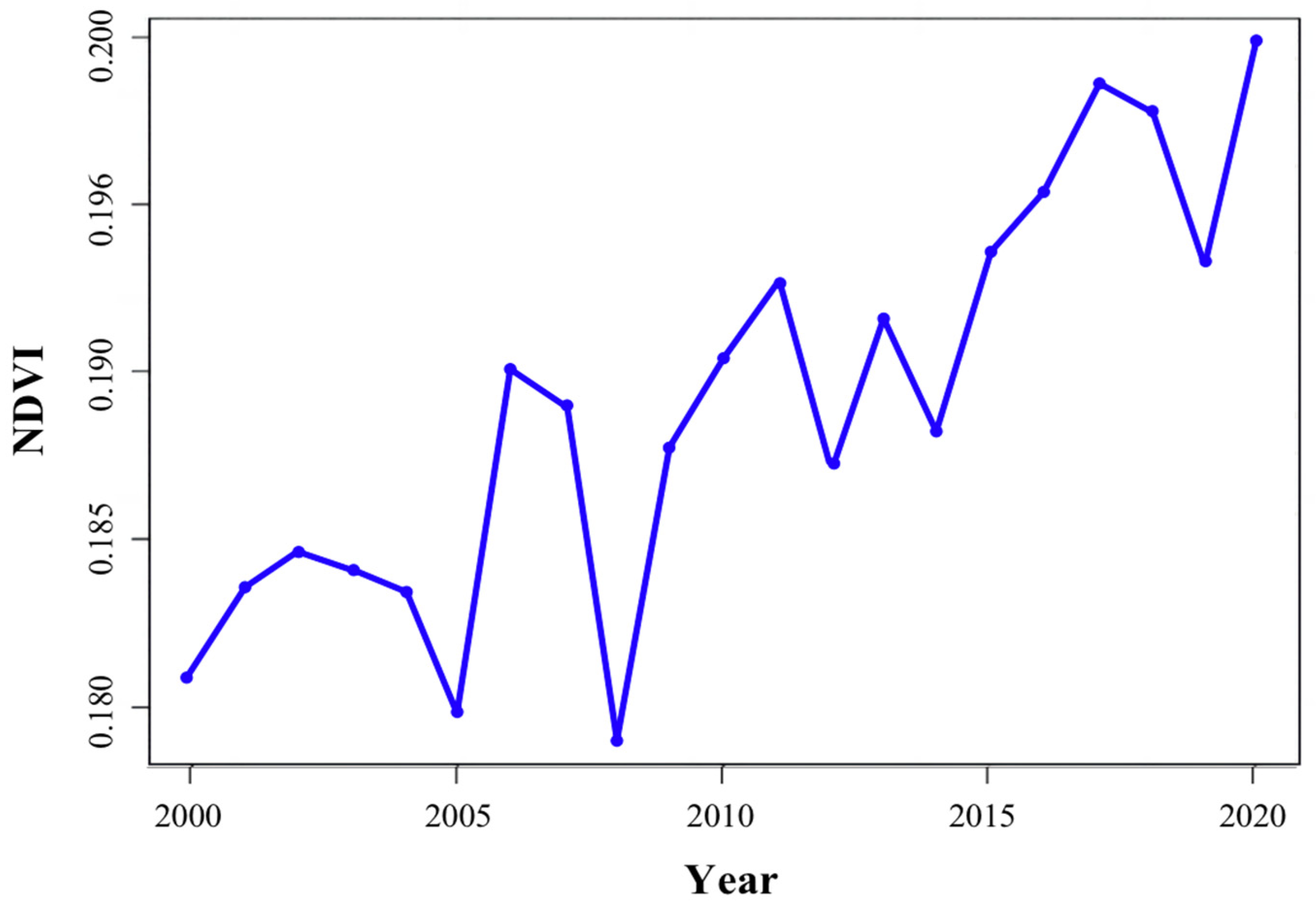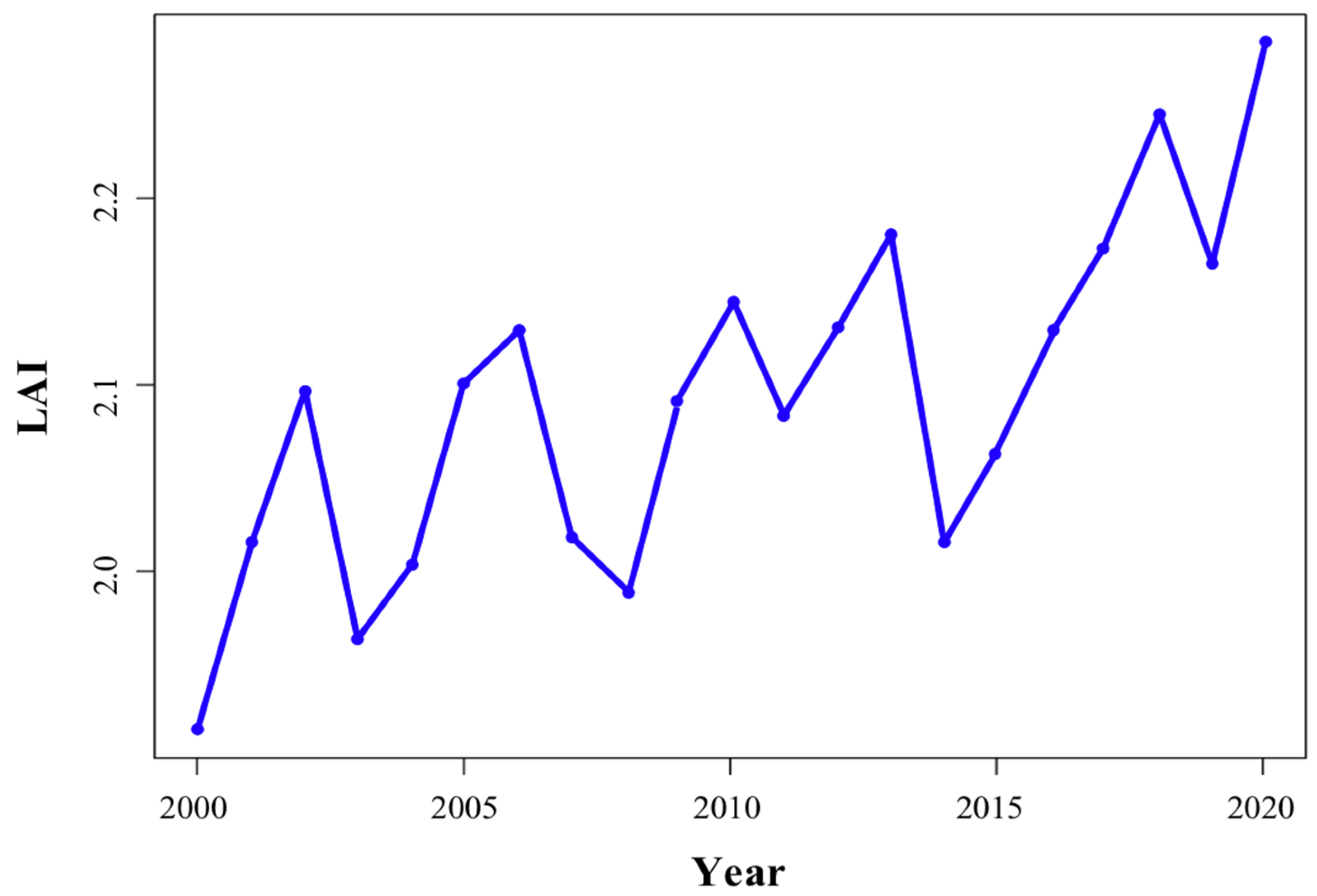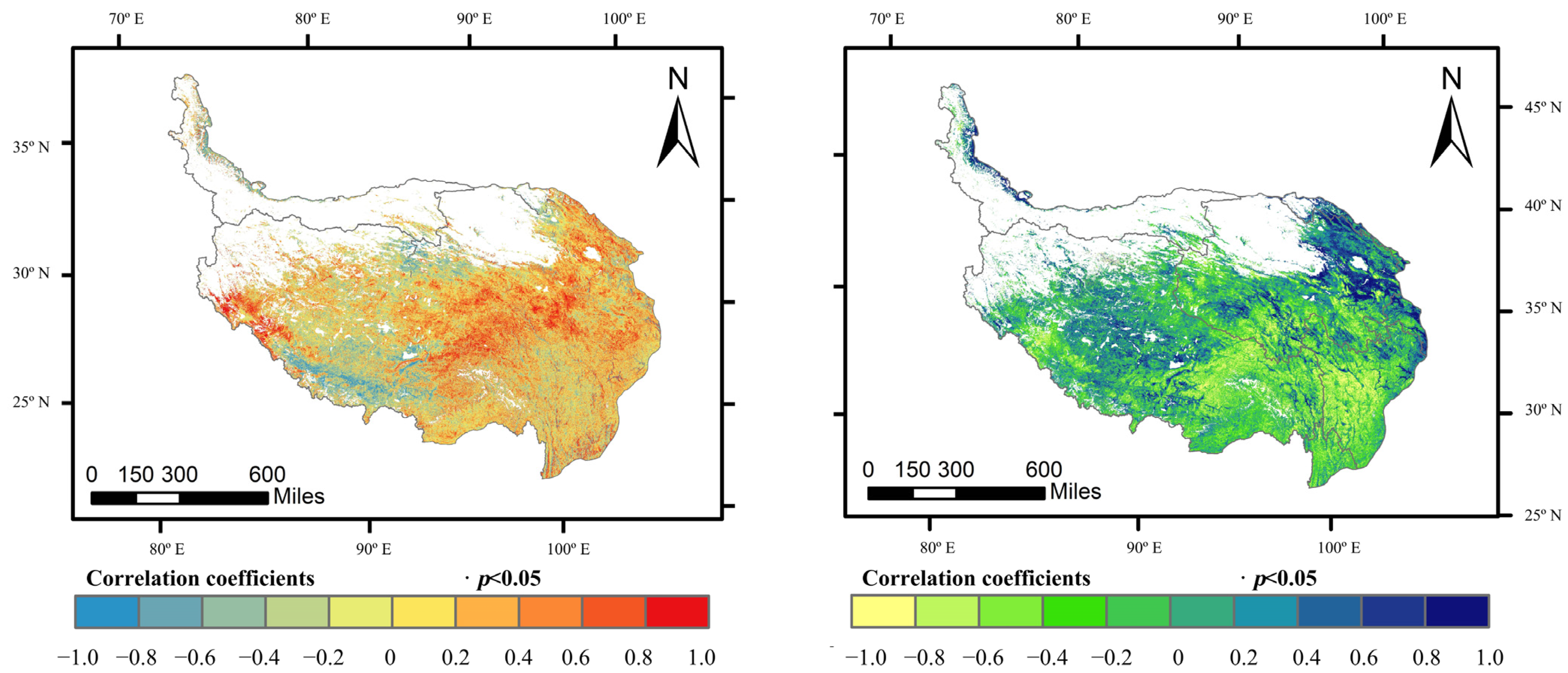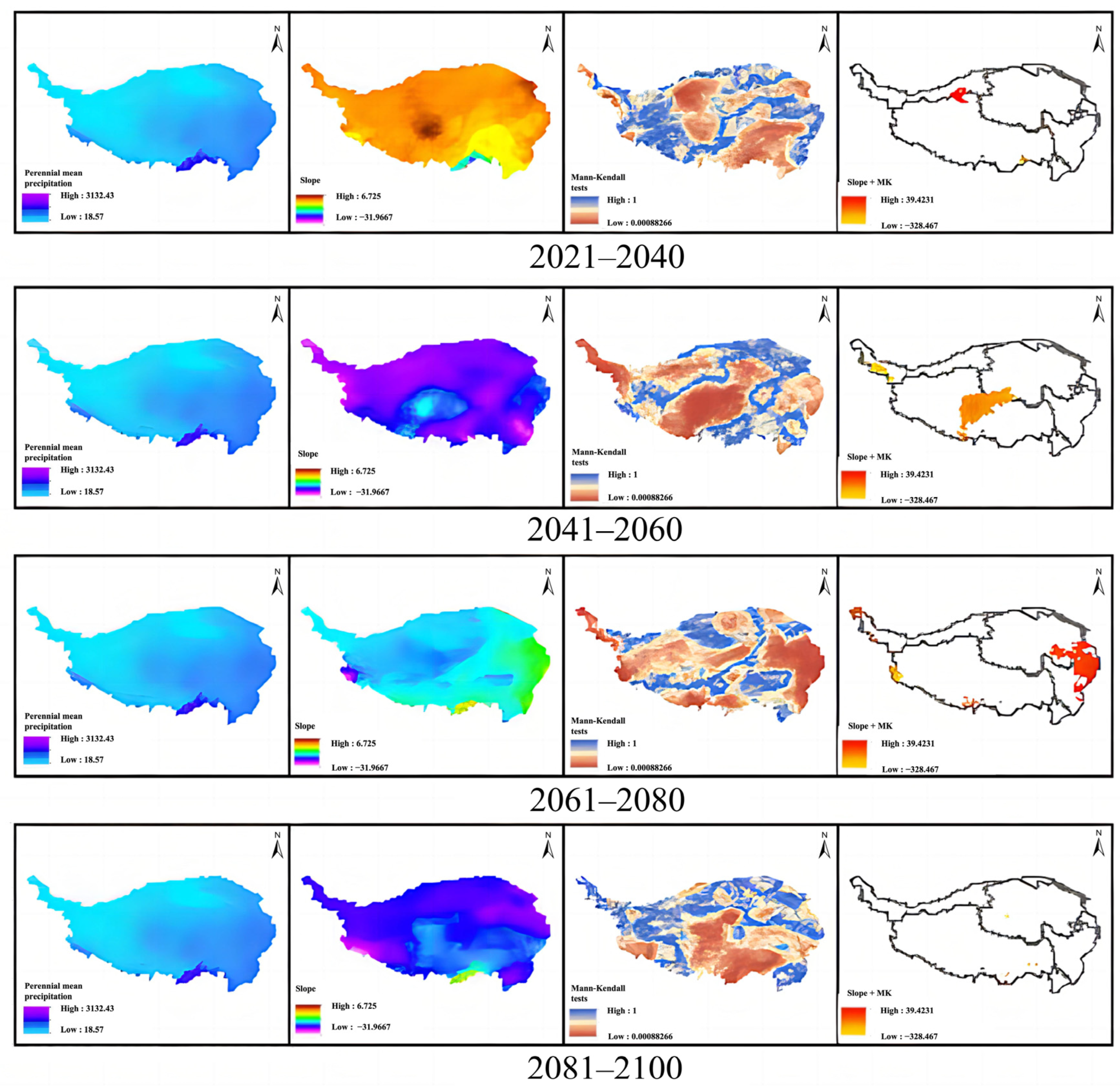Impacts of Climate Warming and Humidification on Vegetation Activity over the Tibetan Plateau
Abstract
:1. Introduction
2. Materials and Methods
2.1. Study Site
2.2. Date Sources and Preprocessing
2.2.1. NDVI Data
2.2.2. LAI Data
2.2.3. Historical Meteorological Data
2.2.4. Future Meteorological Data
2.3. Methods
2.3.1. Trend Significance Test Analysis
2.3.2. Correlation Analysis
2.3.3. Multiple Linear Regression Model
3. Results
3.1. Climate Change on the Tibetan Plateau from 2000 to 2020
3.1.1. Variation Trend of Precipitation of the Qinghai–Tibet Plateau from 2000 to 2020
3.1.2. Trend of Temperature Change in the Tibetan Plateau from 2000 to 2020
3.2. Changes in the Tibetan Plateau’s Ecosystem from 2000 to 2020
3.2.1. Trend of NDVI Change in the Qinghai–Tibet Plateau from 2000 to 2020
3.2.2. Effects of Climate Change on NDVI Trends in the Tibetan Plateau from 2000 to 2020
3.2.3. Trend of LAI Change in the Tibetan Plateau from 2000 to 2020
3.2.4. Effects of Climate Change on LAI Trends of the Tibetan Plateau from 2000 to 2020
3.3. Climate Change Trends of the Tibetan Plateau from 2021 to 2100
3.4. Trends of Ecosystem Changes of the Tibetan Plateau from 2021 to 2100
4. Discussion
5. Conclusions
Author Contributions
Funding
Data Availability Statement
Acknowledgments
Conflicts of Interest
References
- IPCC. Climate Change 2023: The Physical Science Basis. In Contribution of Working Group I to the Sixth Assesment Report of the Intergovernment Panel on Climate Change; Cambridge University Press: Cambridge, UK; New York, NY, USA, 2023. [Google Scholar]
- Jeong, S.J.; Ho, C.H.; Gim, H.J.; Brown, M.E. Phenology shifts at start vs. end of growing season in temperate vegetation over the Northern Hemisphere for the period 1982–2008. Glob. Chang. Biol. 2011, 17, 2385–2399. [Google Scholar] [CrossRef]
- Qiu, J. The third pole. Nature 2008, 45, 393. [Google Scholar] [CrossRef] [PubMed]
- IPCC. Climate Change 2013: The Physical Science Basis. In Contribution of Working Group I to the Fifth Assesment Report of the Intergovernment Panel on Climate Change; Cambridge University Press: Cambridge, UK; New York, NY, USA, 2013. [Google Scholar]
- Chen, H.; Zhu, Q.; Peng, C.; Wu, N.; Wang, Y.; Fang, X.; Gao, Y.; Zhu, D.; Yang, G.; Tian, J.; et al. The impacts of climate change and human activities on biogeochemical cycles on the Qinghai- Tibetan Plateau. Glob. Chang. Biol. 2013, 19, 2940–2955. [Google Scholar] [CrossRef]
- Song, C.; Pei, T.; Zhou, C.H. Research progress of temperature change over the Tibetan Plateau since 1960. Prog. Geogr. 2012, 31, 1503–1509. [Google Scholar]
- Yao, T.D.; Zhu, L.P. Response of the Tibetan Plateau to global change and its adaptation strategies. Adv. Earth Sci. 2006, 5, 459–464. [Google Scholar]
- Zhang, Y.L.; Li, L.H.; Ding, M.J.; Zheng, D. The change of greenness in Qinghai-Tibet Plateau since the new century and its causes. Chin. J. Nat. 2017, 39, 173–178. [Google Scholar]
- Zhao, M.S.; Fu, C.B.; Yan, X.D.; Wen, G. Study on the relationship between vegetation ecosystem and climate in China using remote sensing data. Acta Geogr. Sin. 2001, 3, 287–296. [Google Scholar]
- An, S.; Chen, X.; Zhang, X.; Lang, W.; Ren, S.; Xu, L. Precipitation and Minimum Temperature are Primary Climatic Controls of Alpine Grassland Autumn Phenology on the Qinghai-Tibet Plateau. Remote Sens. 2020, 12, 431. [Google Scholar] [CrossRef]
- Piao, S.; Wang, X.; Ciais, P.; Zhu, B.; Wang, T.A.O.; Liu, J.I.E. Changes in satellite-derived vegetation growth trend in temperate and boreal Eurasia from 1982 to 2006. Glob. Chang. Biol. 2011, 17, 3228–3239. [Google Scholar] [CrossRef]
- Peng, J.; Liu, Z.; Liu, Y.; Wu, J.; Han, Y. Trend analysis of vegetation dynamics in Qinghai-Tibet plateau using Hurs exponent. Ecol. Indic. 2012, 14, 28–39. [Google Scholar] [CrossRef]
- Jin, K.; Wang, F.; Zong, Q.; Qin, P.; Liu, C.; Wang, S. Spatiotemporal differences in climate change impacts on vegetation cover in China from 1982 to 2015. Environ. Sci. Pollut. Res. Int. 2022, 29, 10263–10276. [Google Scholar] [CrossRef] [PubMed]
- Li, G.; Chen, W.; Zhang, X.; Bi, P.; Yang, Z.; Shi, X.; Wang, Z. Spatiotemporal dynamics of vegetation in China from 1981 to 2100 from the perspective of hydrothermal factor analysis. Environ. Sci. Pollut. R 2022, 29, 14219–14230. [Google Scholar] [CrossRef] [PubMed]
- Li, W.; Du, J.; Li, S.; Zhou, X.; Duan, Z.; Li, R.; Wang, S.W.S.; Li, M. The Variation of Vegetation Productivity and Its Relationship to Temperature and Precipitation Based on the GLASS-LAI of Different African Ecosystems from 1982 to 2013. Int. J. Biometeorol. 2019, 63, 847–860. [Google Scholar] [CrossRef]
- Zhang, X.Z.; Yang, Y.P.; Piao, S.L.; Bao, W.K.; Wang, S.P.; Wang, G.X.; Sun, H.; Luo, T.X.; Zhang, Y.J.; Liang, E.Y.; et al. Ecological change on the Tibetan Plateau. Chin. Sci. Bul. 2015, 60, 3048. [Google Scholar]
- Xu, H.; Wang, X.; Zhang, X. Alpine Grasslands Response to Climatic Factors and Anthropogenic Activities on the Tibetan Plateau from 2000 to 2012. Ecol. Eng. 2016, 92, 251–259. [Google Scholar] [CrossRef]
- Zhang, G.L.; Ouyang, H.; Zhang, X.Z.; Zhou, C.P.; Xu, X.L. Vegetation cover change and its response to climate change in the Tibetan Plateau based on ecogeographic regions. Geogr. Res. Aust. 2010, 29, 2004–2016. [Google Scholar]
- Huang, X.; Zhang, T.; Yi, G.; He, D.; Zhou, X.; Li, J.; Bie, X.; Miao, J. Dynamic Changes of NDVI in the Growing Season of the Tibetan Plateau During the Past 17 Years and Its Response to Climate Change. Int. J. Environ. Res. Public Health 2019, 16, 3452. [Google Scholar] [CrossRef] [PubMed]
- Huang, K.; Zhang, Y.; Zhu, J.; Liu, Y.; Zu, J.; Zhang, J. The Influences of Climate Change and Human Activities on Vegetation Dynamics in the Qinghai-Tibet Plateau. Remote Sens. 2016, 8, 876. [Google Scholar] [CrossRef]
- Yao, T.; Thompson, L.G.; Mosbrugger, V.; Zhang, F.; Ma, Y.; Luo, T.; Xu, B.; Yang, X.; Joswiak, D.R.; Wang, W. Third pole environment (TPE). Environ. Dev. 2012, 3, 52–64. [Google Scholar] [CrossRef]
- Chen, X.; An, S.; Inouye, D.W.; Schwartz, M.D. Temperature and snowfall trigger alpine vegetation green-up on the worldʹs roof. Glob. Chang. Biol. 2015, 21, 3635–3646. [Google Scholar] [CrossRef]
- Yang, K.; Ye, B.; Zhou, D.; Wu, B.; Foken, T.; Qin, J.; Zhou, Z. Response of hydrological cycle to recent climate changes in the Tibetan Plateau. Clim. Chang. 2011, 109, 517–534. [Google Scholar] [CrossRef]
- Duan, H.; Xue, X.; Wang, T.; Kang, W.; Liao, J.; Liu, S. Spatial and Temporal Differences in Alpine Meadow, Alpine Steppe and All Vegetation of the Qinghai-Tibetan Plateau and Their Responses to Climate Change. Remote Sens. 2021, 13, 669. [Google Scholar] [CrossRef]
- Zhou, Y.; Zhang, X.; Yu, H.; Liu, Q.; Xu, L. Land Use-Driven Changes in Ecosystem Service Values and Simulation of Future Scenarios: A Case Study of the Qinghai-Tibet Plateau. Sustainability 2021, 13, 4079. [Google Scholar] [CrossRef]
- Kamel, D.; Alfredo, H. MOD13Q1 MODIS/Terra Vegetation Indices 16-Day L3 Global 250 m SIN Grid V006 [Data Set]. Available online: https://lpdaac.usgs.gov/products/mod13q1v006/ (accessed on 22 September 2022).
- Ranga, M.; Knyazikhin, Y. MYD15A2H MODIS/Aqua Leaf Area Index/FPAR 8-Day L4 Global 500 m SIN Grid. Available online: https://lpdaac.usgs.gov/products/myd15a2hv006/ (accessed on 22 September 2022).
- Peng, S.Z. 1-km Monthly Mean Temperature Dataset for China (1901–2022). Available online: https://data.tpdc.ac.cn/en/data/71ab4677-b66c-4fd1-a004-b2a541c4d5bf/ (accessed on 9 October 2022).
- Peng, S.Z. 1-km Monthly Precipitation Dataset for China (1901–2022). Available online: https://zenodo.org/records/3185722 (accessed on 9 October 2022).
- Peng, S.Z. 1 km Multi-Scenario and Multi-Model Monthly Temperature Data for China in 2021–2100. Available online: http://loess.geodata.cn/data/datadetails.html?dataguid=210527645854118&docid=0 (accessed on 9 October 2022).
- Peng, S.Z. 1 km Multi-Scenario and Multi-Model Monthly Precipitation Data for China in 2021–2100. Available online: http://loess.geodata.cn/data/datadetails.html?dataguid=223722163526125&docid=1 (accessed on 9 October 2022).
- Peng, S.Z.; Ding, Y.X.; Wen, Z.M.; Chen, Y.M.; Cao, Y.; Ren, J.Y. Spatiotemporal change and trend analysis of potential evapotranspiration over the Loess Plateau of China during 2011–2100. Agr. For. Meteorol. 2017, 233, 183–194. [Google Scholar] [CrossRef]
- Guclu, Y.S. Improved Visualization for Trend Analysis by Comparing with Classical Mann-Kendall Test and ITA. J. Hydrol. 2020, 584, 124674. [Google Scholar] [CrossRef]
- Jiang, T.; Su, B.D.; Wang, Y.J.; Zhang, Q.; Qin, N.X.; Shi, Y.F. Trends of Temperature, Precipitation and Runoff in the Yangtze River Basin from 1961 to 2000. Adv. Clim. Chang. Res. 2005, 1, 65–68. [Google Scholar]
- Hao, R.; Yu, D.; Liu, Y.; Liu, Y.; Qiao, J.; Wang, X.; Du, J. Impacts of changes in climate and landscape pattern on ecosystem services. Sci. Total Environ. 2017, 579, 718–728. [Google Scholar] [CrossRef] [PubMed]
- Guo, B.; Zang, W.; Yang, F.; Han, B.; Chen, S.; Liu, Y.; Yang, X.; He, T.; Chen, X.; Liu, C.; et al. Spatial and Temporal Change Patterns of Net Primary Productivity and Its Response to Climate Change in the Qinghai-Tibet Plateau of China from 2000 to 2015. J. Arid. Land 2020, 12, 1–17. [Google Scholar] [CrossRef]
- Tong, L.; Liu, Y.; Wang, Q.; Zhang, Z.; Li, J.; Sun, Z.; Khalifa, M. Relative Effects of Climate Variation and Human Activities on Grassland Dynamics in Africa from 2000 to 2015. Ecol. Inform. 2019, 53, 100979. [Google Scholar] [CrossRef]
- Movchan, D.; Kostyuchenko, Y.V. Regional Dynamics of Terrestrial Vegetation Productivity and Climate Feedbacks for Territory of Ukraine. Int. J. Geogr. Inf. Sci. 2015, 29, 1490–1505. [Google Scholar] [CrossRef]
- Kang, S.; Xu, Y.; You, Q.; Fluegel, W.-A.; Pepin, N.; Yao, T. Review of Climate and Cryospheric Change in the Tibetan Plateau. Environ. Res. Lett. 2010, 5, 015101. [Google Scholar] [CrossRef]
- Chen, J.; Kuang, X.; Lancia, M.; Yao, Y.; Zheng, C. Analysis of the Groundwater Flow System in a High-Altitude Headwater Region under Rapid Climate Warming: Lhasa River Basin, Tibetan Plateau. J. Hydrol. Reg. Stud. 2021, 36, 100871. [Google Scholar] [CrossRef]
- Wang, C.; Guo, Y. Precipitable Water Conversion Rates over the Qinghai-Xizang (Tibet) Plateau: Changing Characteristics with Global Warming. Hydrol. Process. 2012, 26, 1509–1516. [Google Scholar] [CrossRef]
- Ding, M.; Chen, Q.; Li, L.; Zhang, Y.; Wang, Z.; Liu, L.; Sun, X. Temperature Dependence of Variations in the End of the Growing Season from 1982 to 2012 on the Qinghai-Tibetan Plateau. GISci. Remote Sens. 2016, 53, 147–163. [Google Scholar] [CrossRef]
- Fan, Z.; Bai, R.; Yue, T. Spatio-Temporal Distribution of Vascular Plant Species Abundance on Qinghai-Tibet Plateau. J. Geogr. Sci. 2019, 29, 1625–1636. [Google Scholar] [CrossRef]
- Jiapaer, G.; Liang, S.; Yi, Q.; Liu, J. Vegetation Dynamics and Responses to Recent Climate Change in Xinjiang Using Leaf Area Index as an Indicator. Ecol. Indic. 2015, 58, 64–76. [Google Scholar]
- Hu, Y.; Li, H.; Wu, D.; Chen, W.; Zhao, X.; Hou, M.; Li, A.; Zhu, Y. LAI-Indicated Vegetation Dynamic in Ecologically Fragile Region: A Case Study in the Three-North Shelter Forest Program Region of China. Ecol. Indic. 2021, 120, 106932. [Google Scholar] [CrossRef]
- Liang, B.; Liu, H.; Chen, X.; Zhu, X.; Cressey, E.L.; Quine, T.A. Periodic Relations between Terrestrial Vegetation and Climate Factors across the Globe. Remote Sens. 2020, 12, 1805. [Google Scholar] [CrossRef]
- Kuzyakov, Y.; Gavrichkova, O. Review: Time Lag between Photosynthesis and Carbon Dioxide Efflux from Soil: A Review of Mechanisms and Controls. Glob. Chang. Biol. 2010, 16, 3386–3406. [Google Scholar] [CrossRef]
- Chen, J.; Yan, F.; Lu, Q. Spatiotemporal Variation of Vegetation on the Qinghai-Tibet Plateau and the Influence of Climatic Factors and Human Activities on Vegetation Trend (2000–2019). Remote Sens. 2020, 12, 3150. [Google Scholar] [CrossRef]
- Lucht, W.; Prentice, I.C.; Myneni, R.B.; Sitch, S.; Friedlingstein, P.; Cramer, W.; Bousquet, P.; Buermann, W.; Smith, B. Climatic Control of the High-Latitude Vegetation Greening Trend and Pinatubo Effect. Science 2002, 296, 1687–1689. [Google Scholar] [CrossRef]
- Richardson, A.D.; Black, T.A.; Ciais, P.; Delbart, N.; Friedl, M.A.; Gobron, N.; Hollinger, D.Y.; Kutsch, W.L.; Longdoz, B.; Luyssaert, S.; et al. Influence of Spring and Autumn Phenological Transitions on Forest Ecosystem Productivity. Philos. Trans. R. Soc. B-Biol. Sci. 2010, 365, 3227–3246. [Google Scholar] [CrossRef]
- von Luetzow, M.; Koegel-Knabner, I. Temperature Sensitivity of Soil Organic Matter Decomposition-What Do We Know? Biol. Fertil. Soils 2009, 46, 1–15. [Google Scholar] [CrossRef]
- Wang, G.; Baskin, C.C.; Baskin, J.M.; Yang, X.; Liu, G.; Ye, X.; Zhang, X.; Huang, Z. Effects of Climate Warming and Prolonged Snow Cover on Phenology of the Early Life History Stages of Four Alpine Herbs on the Southeastern Tibetan Plateau. Am. J. Bot. 2018, 105, 967–976. [Google Scholar] [CrossRef] [PubMed]
- Pepin, N.; Bradley, R.S.; Diaz, H.F.; Baraer, M.; Caceres, E.B.; Forsythe, N.; Fowler, H.; Greenwood, G.; Hashmi, M.Z.; Liu, X.D.; et al. Elevation-dependent warming in mountain regions of the world. Nat. Clim. Chang. 2015, 5, 424–430. [Google Scholar]
- Zhang, J.; Huang, S.; He, F. Half-century evidence from western canada shows forest dynamics are primarily driven by competition followed by climate. Proc. Natl. Acad. Sci. USA 2015, 112, 4009–4014. [Google Scholar] [CrossRef]
- Chen, J.; Yang, Y.; Wang, S.; Sun, H.; Schob, C. Shrub facilitation promotes selective tree establishment beyond the climatic treeline. Sci. Total Environ. 2020, 708, 134618. [Google Scholar] [CrossRef]
- Crimmins, S.M.; Dobrowski, S.Z.; Greenberg, J.A.; Abatzoglou, J.T.; Mynsberge, A.R. Changes in climatic water balance drive downhill shifts in plant species’ optimum elevations. Science 2011, 331, 324–327. [Google Scholar] [CrossRef]
- Chen, X.; Li, J.; Xu, L.; Liu, L.; Ding, D. Modeling greenup date of dominant grass species in the inner Mongolian grassland using air temperature and precipitation data. Int. J. Biometeorol. 2014, 58, 463–471. [Google Scholar] [CrossRef]
- Cui, J.; Wang, Y.; Zhou, T.; Jiang, L.; Qi, Q. Temperature Mediates the Dynamic of MODIS NPP in Alpine Grassland on the Tibetan Plateau, 2001–2019. Remote Sens. 2022, 14, 2401. [Google Scholar] [CrossRef]
- Liu, B.; Wang, Y.; Zhu, H.; Liang, E.; Camarero, J.J. Topography and Age Mediate the Growth Responses of Smith Fir to Climate Warming in the Southeastern Tibetan Plateau. Int. J. Biometeorol. 2016, 60, 1577–1587. [Google Scholar] [CrossRef]
- Gao, Q.; Guo, Y.; Xu, H.; Ganjurjav, H.; Li, Y.; Wan, Y.; Qin, X.; Ma, X.; Liu, S. Climate Change and Its Impacts on Vegetation Distribution and Net Primary Productivity of the Alpine Ecosystem in the Qinghai-Tibetan Plateau. Sci. Total Environ. 2016, 554, 34–41. [Google Scholar] [CrossRef]
- Wang, Y.; Peng, D.; Shen, M.; Xu, X.; Yang, X.; Huang, W.; Yu, L.; Liu, L.; Li, C.; Li, X.; et al. Contrasting Effects of Temperature and Precipitation on Vegetation Greenness along Elevation Gradients of the Tibetan Plateau. Remote Sens. 2020, 12, 2751. [Google Scholar] [CrossRef]
- Ouyang, W.; Wan, X.; Xu, Y.; Wang, X.; Lin, C. Vertical Difference of Climate Change Impacts on Vegetation at Temporal-Spatial Scales in the Upper Stream of the Mekong River Basin. Sci. Total Environ. 2020, 701, 134782. [Google Scholar] [CrossRef] [PubMed]
- Wu, D.; Zhao, X.; Liang, S.; Zhou, T.; Huang, K.; Tang, B.; Zhao, W. Time-Lag Effects of Global Vegetation Responses to Climate Change. Glob. Chang. Biol 2015, 21, 3520–3531. [Google Scholar] [CrossRef]
- Liu, R.; Xiao, L.; Liu, Z.; Dai, J. Quantifying the Relative Impacts of Climate and Human Activities on Vegetation Changes at the Regional Scale. Ecol. Indic. 2018, 93, 91–99. [Google Scholar] [CrossRef]
- Zhang, Y.; Xu, G.; Li, P.; Li, Z.; Wang, Y.; Wang, B.; Jia, L.; Cheng, Y.; Zhang, J.; Zhuang, S.; et al. Vegetation Change and Its Relationship with Climate Factors and Elevation on the Tibetan Plateau. Int. J. Environ. Res. Public Health 2019, 16, 4709. [Google Scholar] [CrossRef]















Disclaimer/Publisher’s Note: The statements, opinions and data contained in all publications are solely those of the individual author(s) and contributor(s) and not of MDPI and/or the editor(s). MDPI and/or the editor(s) disclaim responsibility for any injury to people or property resulting from any ideas, methods, instructions or products referred to in the content. |
© 2023 by the authors. Licensee MDPI, Basel, Switzerland. This article is an open access article distributed under the terms and conditions of the Creative Commons Attribution (CC BY) license (https://creativecommons.org/licenses/by/4.0/).
Share and Cite
He, Z.; Zhou, T.; Chen, J.; Fu, Y.; Peng, Y.; Zhang, L.; Yao, T.; Farooq, T.H.; Wu, X.; Yan, W.; et al. Impacts of Climate Warming and Humidification on Vegetation Activity over the Tibetan Plateau. Forests 2023, 14, 2055. https://doi.org/10.3390/f14102055
He Z, Zhou T, Chen J, Fu Y, Peng Y, Zhang L, Yao T, Farooq TH, Wu X, Yan W, et al. Impacts of Climate Warming and Humidification on Vegetation Activity over the Tibetan Plateau. Forests. 2023; 14(10):2055. https://doi.org/10.3390/f14102055
Chicago/Turabian StyleHe, Zhe, Ting Zhou, Jiaqi Chen, Yajing Fu, Yuanying Peng, Li Zhang, Tongyu Yao, Taimoor Hassan Farooq, Xiaohong Wu, Wende Yan, and et al. 2023. "Impacts of Climate Warming and Humidification on Vegetation Activity over the Tibetan Plateau" Forests 14, no. 10: 2055. https://doi.org/10.3390/f14102055
APA StyleHe, Z., Zhou, T., Chen, J., Fu, Y., Peng, Y., Zhang, L., Yao, T., Farooq, T. H., Wu, X., Yan, W., & Wang, J. (2023). Impacts of Climate Warming and Humidification on Vegetation Activity over the Tibetan Plateau. Forests, 14(10), 2055. https://doi.org/10.3390/f14102055






